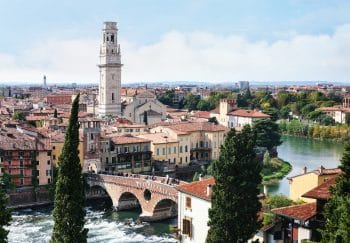Pompeii was once a vibrant, blue-collar port town. But the fate of Pompeii was sealed by the eruption of Mount Vesuvius 7.9 A.D. Our easy guide will help you plan your trip to Pompeii. It is the best way to experience life in ancient Rome.
How to get there
Via di Mercurio, Mercury street, under steaming Vesuvius. Carlo Mirante
It is easy to get to Pompeii from all the surrounding cities by bus, train or car. It takes 2.5 hours to travel by road without traffic, approximately 45 minutes to get from Naples to Pompeii to Sorrento, 4.5 hours to get from Florence to Pompeii to (which is pretty much ruled out as a day trip from Florence).
The easiest way to visit Pompeii is from Rome. This Pompeii and Amalfi Day Tour from Rome includes a guided tour, scenic drive along Amalfi Coast, and stop in Positano. A transfer service can be booked by independent travelers. Although it is the most convenient, it may not be the cheapest. Budget-conscious travelers will prefer to travel by train. It is easier to navigate, less expensive, but takes more time.
Take the train from Rome to Naples at Napoli Centrale Station. It takes approximately one hour and ten minutes to travel by high-speed train Frecciarossa, or Italo. www.trenitalia.com allows you to view train times, prices and book your tickets online in advance. Take the Napoli Centrale Circumvesuviana train. This is the reliable and old commuter train in Campania. It runs on the Napoli – Sorento Circumvesuviana railway. Circumvesuviana trains run every 30 minutes and take approximately 30 minutes to reach your Pompeii stop (Pompeii Scavi-Villa dei Misteri).
You can take the Napoli–Sorrento Circumvesuviana train from Naples or Sorrento to the Pompeii Scavi-Villa dei Misteri station. It takes about 30 minutes to get from one city to the other. You might have to stand if you are on one of the Circumvesuviana trains. This website provides more information on the Circumvesuviana train schedules and prices.
You can get a better view (although it is rocky and potentially crowded) of the Almafi Coast by taking the SITA bus to Piazza Esedra, Naples, or the Sorrento station. There are usually one or two buses per hour that stop at major coastal towns, including Pompei, the modern-day town, and Pompeii, the archaeological site. The trip takes approximately 40 minutes and costs 2.80 euros. For more information, visit the SITA website (in Italian).
Continue reading: A Guide for Art Lovers to Pompeii – The City Frozen in Time
What to bring
Visitors facilities are not given the same attention. The site has only one restaurant-cum-cafeteria of dubious quality, and the maps – if you can get one from the information booth – are not up to date (you may have to backtrack where streets have been blocked off).
Remember that Pompeii was once a whole maritime city. The current site is huge! There are forty-four hectares of excavated land, but not all of them are accessible. The beautiful site is not managed well. Many areas are fenced off without explanation or signage. A tour guide will make sure your itinerary is well-planned so that you don’t have to worry about it. Plan ahead to make sure you have a great trip.
Walking through the streets preserved by the city is a great way to go back in history. This is the best way of seeing Pompeii. Although you could spend a whole day exploring the site, it takes about two to three hours on average. Pompeii, like most Roman-built cities is well-organized with a clear streetplan, but modern-day signs are often incorrect. Although the information booth should be equipped with maps, you will need to ask and wait for it to be updated. It is better to bring a map. Although Pompeii can be toured in a day, it is easy to get lost or over-baked under the Neapolitan sun. Solo travelers might consider purchasing a guidebook.
A 1912 Map of Pompeii depicts the immense size of the site. Dennis Jarvis
No matter the season, you should always bring sunscreen and hats. In summer, umbrellas may be a good idea. You will feel more like a homeless person than you are a healthy person after spending two to three hours in the sun. For all the walking, you’ll need snacks and water. There is one convenience stand inside, with limited offerings and unreliable hours. However, there are many water fountains around the site where you can refill your water bottles.
Pompeii Tickets
It costs 11 euro to enter Pompeii, or about 13 US dollars at the moment. However, you should have cash because the ticket office does not accept credit cards. You can get more information, view prices or book ahead here.
What to See
Pompeii, a port town in the ancient Roman Empire that controlled the entire Mediterranean Sea, was important before Vesuvius’ eruption of 79 AD. Pompeii, which was considered middle class, was a port town full of sailor’s bars, bars, public baths and taverns. Visitors to Pompeii, once bustling, now have the opportunity to see the archeological site as well as ongoing excavations. Visit the Roman Forum, the theatre whose acoustics make it possible to hear the audience from the stage. Also visit the public baths that are adorned with tall columns. The Anfiteatro, a Roman amphitheatre built in 70 A.D. is still in use. It is now covered with grass and used to hold up to 20,000 people.
The ground was indented by archaeologists, which they were able fill with plaster molds that exactly match the original. Carlo Mirante
Forum (or Foro in Italian) was Pompeii’s main piazza. It leads to other noteworthy sights such as the Basilica, built in the second century BC, and the Temple of Jupiter (Tempio di Giove). There is only one triumphal arch left, the Forum Granary, which houses the city’s primary meat- and fish market.
There are also many other options for tours, including small family restaurants, ancient Roman homes, and bakeries. You can even visit a local brothel where you will find vibrant frescos and “Umberto is here” graffiti. The House of the Vetti is at the opposite end of the social classes spectrum. It was the home of a wealthy merchant, and one of the most well-preserved homes. Although it was recently closed for renovations you can still see the typical villa of Pompeii’s wealthiest citizens. There are also large rooms with frescoes in the inner courtyard and small fish ponds.
Since the Neapolitan King in the 1700s ordered many of the Pompeii artifacts to Naples, they are now housed at the National Museum of Archaeology. The museum is a must-see for archaeologists and history buffs. It offers the best view of Pompeii’s art, from large statues and mosaics to everyday objects. The Pompeii Archaeological Site has all the ruins, but the Naples Archaeological Museum contains all the objects discovered during excavations.
Continue reading Why Pompeii is a Bad Idea without Visiting Mount Vesuvius
What remains from the second century Basilica. Dennis Jarvis photo
Take a final look at Mount Vesuvius, the magnificent view in the distance before you leave Pompeii. The still-active volcano created a cloud of gas and ash 2,000 years ago. It erupted for hours, forcing most residents to flee. In a matter of seconds, the eruption changed and an avalanche lava and rocks raced down the mountainside towards Pompeii. Although Vesuvius was able to destroy the city, it also preserved it. It stopped Pompeii’s destruction and gave us most of the information we have about the ancient city.











